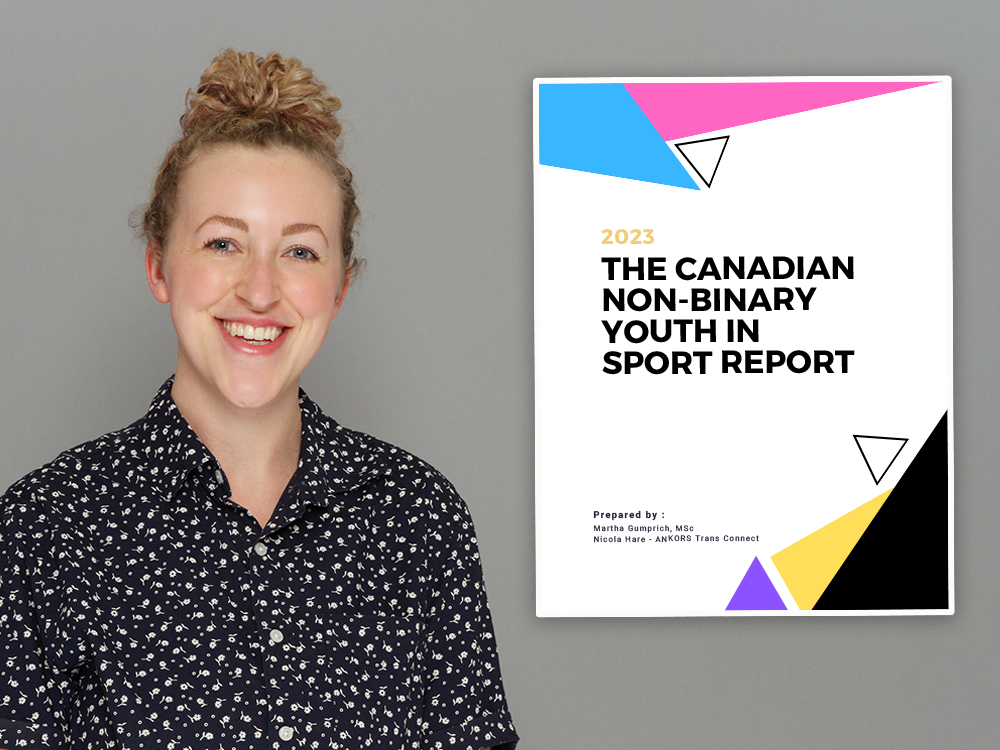Canadian Non-Binary Youth in Sport Report: Solutions posed by trans and non-binary youth

The experiences of trans and non-binary youth in Canadian organized team sports has vastly been understudied and it is time for their voices to be heard.
The Canadian Non-Binary Youth in Sport Report has recently been published and we interviewed the lead author, Martha Gumprich, to learn more about their report and how it can support gender minority students in Physical and Health Education (PHE) classes, and other physical activity settings. The report, both informative and solution based, amplifies the needs and experiences of non-binary youth in sport. By highlighting staggering statistics of “non-binary youth participation in and avoidance of sport, and experiences of abuse or discrimination” this report proposes tangible ways “to help make a safer environment for all genders” in many physical activity spaces.
Tell us a bit about yourself and your research:
I am a graduate of Simon Fraser University (SFU) with an MSc in Health Science. With a background in Kinesiology and Athletic Therapy, I have experience working in a variety of sports settings which has shown me the many ways LGBTQ+ and non-binary athletes are excluded or discriminated against. Having worked in men’s sports, I have witnessed homophobic and sexist jokes that are commonly brushed off as “locker room talk” and are just “part of the game.”
My research looked at the experiences of non-binary* youth** in organized team sports in Canada. I investigated the many barriers non-binary youth face when entering and remaining in sport (both in and outside of school), with the goal of making sport safer and more inclusive for all genders. My research looked at the experiences of 2, 513 non-binary and 1, 929 cisgender youth. After I had my findings, I partnered with a community group, Trans Connect. We held three focus group sessions with queer and gender minority youth to hear solutions they want to see for the issues non-binary youth are facing in sport. During these sessions, I presented my main thesis findings, and our participants got to share what they would like to see change both in schools and in organized sports. After these sessions, we created the national report and a series of infographics to be shared on all social media platforms.
*Non-binary means someone does not identify as a boy/man or girl/woman, or may identify as both.
**Youth, in this context, refers to those ages 15-29.
Was there anything in particular that motivated you to conduct this type of research?
While we’re starting to see more visibility of non-binary people in Canada, we know that non-binary youth are uncertain about how welcome and safe they are in gendered spaces, like team sports. Most notably in high-performance sport, World Athletics, World Rugby and FINA (International Swimming Federation) have banned trans women who have gone through male puberty from competing in international events. When I began my thesis research in September 2021, there was only a handful of states in the US that had enacted laws banning trans youth from participating on a team that aligns with their gender identity. When I was finishing writing my thesis in March 2023, there were 18 states with anti-trans bans (Movement Advancement Project, 2023). Now, in December 2023, there are 23. Transphobia is spreading rapidly and Canada is not immune. Canada is not immune to anti-trans policies and laws, as we see in Saskatchewan and New Brunswick with their new pronoun and name policies.
There has been some previous research on transgender participation in sports (Barras et al., 2021, Braumüller et al., 2020, Egale, 2020), but no research on participation rates and experiences of non-binary youth in organized team sports in Canada. Some sports organizations have also created explicit policies that instruct teams in best practices to include transgender participants (E-Alliance, 2022). This has not been the case for non-binary people who are often included or excluded on a case-by-case basis (Spencer, 2020). In order to make sport a safer place for all participants, we must first listen to those both participating in and avoiding sports to see where changes need to be made.
What were some of the main findings from your research?
The main finding from my study is that all of the reasons why non-binary youth are avoiding sport are preventable. Nearly all of them can be addressed immediately through education and policy changes. If we act now and put in place proactive, and protective policies, these youth may join and stay in sport which we know leads to many mental and physical health benefits. The mental health benefits from team sports cover many age groups (Andersen et al., 2019; Guddal et al., 2019; Tyson et al., 2010). Playing on a team facilitates friendships, a greater social network (Andersen et al., 2019), improved self-esteem and social skills (Eime et al., 2013), and a greater engagement in life (Halliday et al. 2019). This is especially important for this population as research has shown that LGBTQ+ people have worse mental health outcomes compared to those who are heterosexual or cisgender (Ferlatte et al., 2020). Key notes from my research found that:
-
66% of non-binary youth in Canada who have avoided joining an organized team sport have done so because they would have to play on a binary gendered (men's or women's) team.
-
4 in 5 non-binary youth who avoided sport, did so because of change room and locker room layouts.
-
1 in 2 avoided a team because of teammates and coaches potentially making them feel unsafe when participating.
-
Participation rates are very low for non-binary youth, as I found that only 11% of our surveyed non-binary youth are currently participating in organized team sport(s) (either inside or outside of school).
Based on your research, where do you see the future of Physical and/or Health Education?
I see a lot of potential for Physical and Health Education. While many youth are having negative experiences in PE classes and organized sports, teachers can make their classes a safer space for all by following our very clearly laid out solutions in our report. Many youth want to participate in PE classes and have fun with classmates, but they are unable to do so because of the gendered nature of sports and change rooms. If teachers continue their education about the non-binary community, read our report, and listen to the needs of their students, PE class can become a very positive experience for all participants.
What would you recommend teachers and school boards do to support non-binary and/or gender diverse youth with physical activity, Physical and Health Education, and/or sport?
Teachers can:
-
Allow non-binary students to participate on the gendered team of their choice.
-
In PE classes, make teams co-ed or divided by competitiveness rather than by gender.
-
Learn student’s pronouns and preferred names.
-
Listen to any needs expressed by non-binary and trans students and then work to address them.
School boards need to create policies that implement our clearly laid-out solutions. This will ensure that these simple ways to include all students are not done solely at the discretion of a teacher. While teachers are looking for ways to include non-binary students, and I have heard of teachers doing some really great work in their school, many do not know where to start or what is the best way to go about making sure every student is welcome and safe. Policies created by school boards have the power to protect non-binary and trans students. These policies need to include:
-
Easily accessible gender-neutral changing areas and bathrooms for students. If this is not possible in the short term, shower curtains can be installed in changerooms to create private spaces for students to change, rather than having to change in the open in front of others.
-
The use of a person’s pronouns and preferred name.
-
Allowing a non-binary student to choose the gendered team they wish to play on.
-
Allowing a non-binary student to wear the gendered jersey/uniform of their choice.
School boards also need to offer workshops hosted by experts for teachers on professional development days to learn about diverse sexualities and genders.
What advice would you give gender diverse youth when it comes to participating in physical activity and/or sport?
My tip for youth is for them to remember that they are incredibly valued and an important person on their team. They know who they are better than anyone else, and I hope they can find people who understand and support them. I want them to know that work is being done to make physical activity and sport a safer place for non-binary and gender minority youth, and we will not stop until all youth are able to participate safely in sport.
References:
Andersen, M. H., Ottesen, L., & Thing, L. F. (2019). The social and psychological health outcomes of team sport participation in adults: An integrative review of research. Scandinavian Journal of Public Health, 47(8), 832–850. https://doi.org/10.1177/1403494818791405
Barras, A., Frith, H., Jarvis, N., & Lucena, R. (2021). Timelines and Transitions. In B. C. Clift, J. Gore, S. Gustafsson, S. Bekker, I. C. Batlle, & J. Hatchard (Eds.), Temporality in Qualitative Inquiry: Theories, Methods and Practices. Routledge.
Braumüller, B., Menzel, T., & Hartmann-Tews, I. (2020). Gender Identities in Organized Sports—Athletes’ Experiences and Organizational Strategies of Inclusion. Frontiers in Sociology, 5(October), 1–17. https://doi.org/10.3389/fsoc.2020.578213
E-Alliance. (2022). Transgender Women Athletes and Elite Sport: A Scientific Review. https://www.cces.ca/sites/default/files/content/docs/pdf/transgenderwomenathlete sandelitesport-ascientificreview-e-final.pdf
Egale. (2020). Sports Inclusion in Canada: Literature Review (Issue September, pp. 1– 27). https://egale.ca/awareness/sports-inclusion/
Eime, R. M., Young, J. A., Harvey, J. T., Charity, M. J., & Payne, W. R. (2013). A systematic review of the psychological and social benefits of participation in sport for adults: Informing development of a conceptual model of health through sport. International Journal of Behavioral Nutrition and Physical Activity, 10(98), 1–21. https://doi.org/10.1186/1479-5868-10-135
Ferlatte, O., Salway, T., Rice, S. M., Oliffe, J. L., Knight, R., & Ogrodniczuk, J. S. (2020). Inequities in depression within a population of sexual and gender minorities. Journal of Mental Health, 29(5), 573–580. https://doi.org/10.1080/09638237.2019.1581345
Guddal, M. H., Stensland, S. Ø., Småstuen, M. C., Johnsen, M. B., Zwart, J. A., & Storheim, K. (2019). Physical activity and sport participation among adolescents: Associations with mental health in different age groups. Results from the Young- HUNT study: A cross-sectional survey. BMJ Open, 9(9), 1–10. https://doi.org/10.1136/bmjopen-2018-028555
Gumprich, M., & Hare , N. (2023) The Canadian Non-binary Youth in Sport Report.
Halliday, A. J., Kern, M. L., & Turnbull, D. A. (2019). Can physical activity help explain the gender gap in adolescent mental health? A cross-sectional exploration. Mental Health and Physical Activity, 16(March), 8–18. https://doi.org/10.1016/j.mhpa.2019.02.003
Movement Advancement Project. (2023, December 18). Equality Maps: Bans on Transgender Youth Participation in Sports. Movement Advancement Project. https://www.lgbtmap.org/equality-maps/sports_participation_bans
Spencer, D. (2020, June 2). Non-binary athletes navigating Canadian sport with little policy help. CBC. https://www.cbc.ca/sports/canada-non-binary-athletes-1.5585435#:~:text=Sports-,Non%2Dbinary%20athletes%20navigating%20Canadian%20sport%20with%20little%20policy%20help,t%20address%20non%2Dbinary%20people.
Tyson, P., Wilson, K., Crone, D., Brailsford, R., & Laws, K. (2010). Physical activity and mental health in a student population. Journal of Mental Health, 19(6), 492–499. https://doi.org/10.3109/09638230902968308








